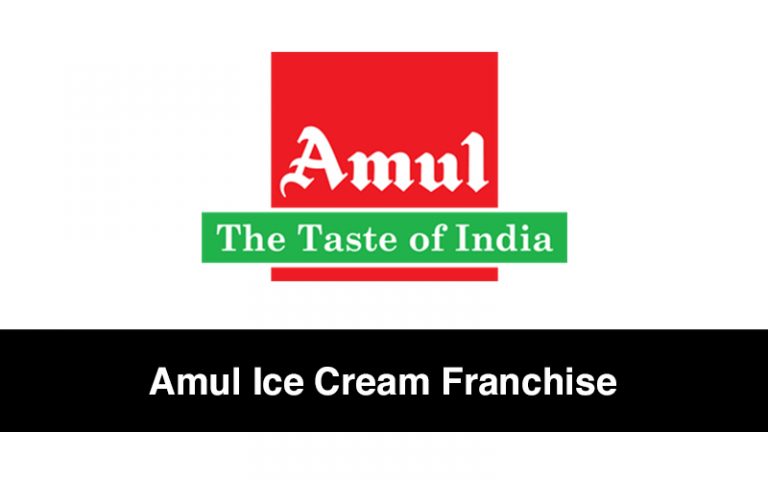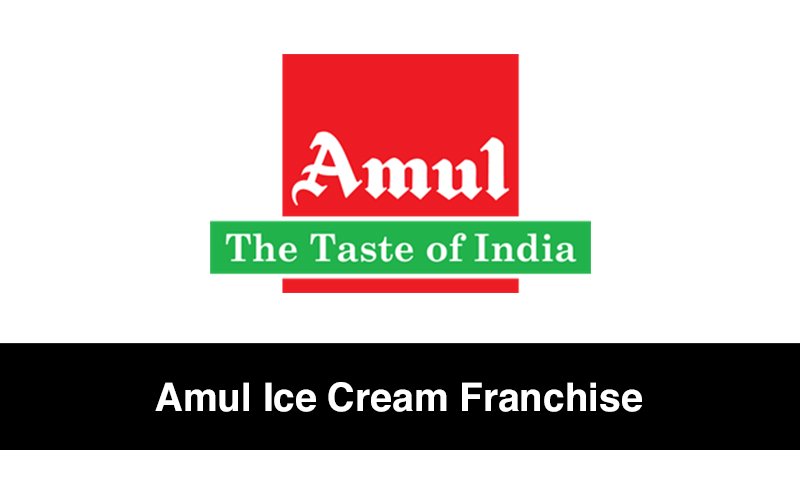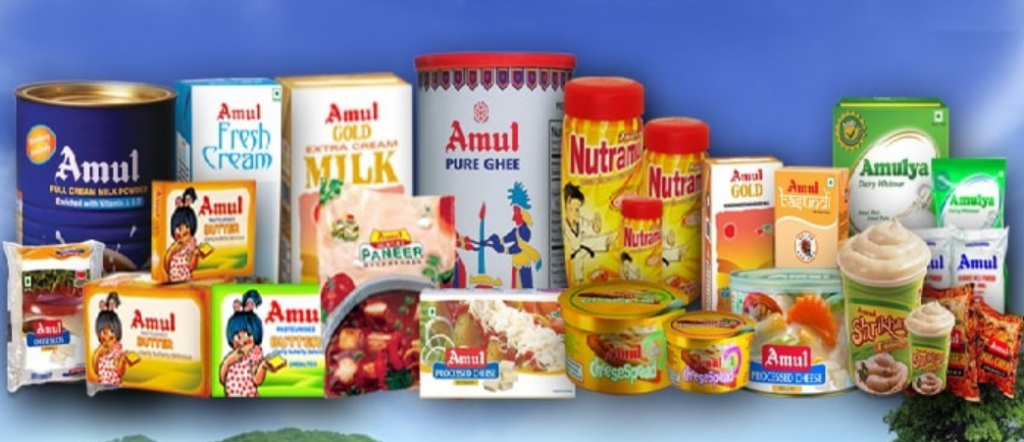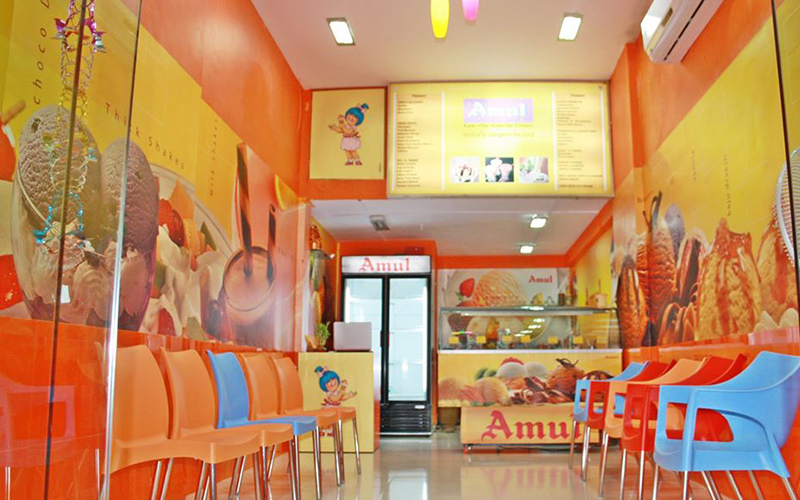
Milk, butter, Curd, Lassi, Cottage Cheese – one cannot imagine their food without at least one of these items in India where milk and milk products are an essential part of cuisines in different parts of the country. India, a nation of 1.25 billion people, is a place where a large variety of dairy products are consumed in large quantities.
If there is one brand that has ingrained its roots in India, it is Amul. Whether it is milk, butter, cheese or ice cream, the first brand name that pops up into most Indians’ heads is Amul.
Today, ice creams have made their way into every Indian household. It has become a custom to eat ice cream as dessert after a family dinner. Every individual has their preference – some like the chocolate flavor, some vanilla and others butterscotch. There is also no particular season to have it. People eat it in winters and summers alike. People from all age groups consume ice cream. Amul provides a wide variety of choices when it comes to ice creams and there are as many products for children and as there are for the elderlies.
About the Company:
If there is any brand in India that has become a household name, it is Amul. The word ‘Amul’ itself has become synonymous with dairy. The name ‘Amul’ is derived from the Sanskrit word ‘Amoolya’ which translates to priceless or precious. It is an Indian cooperative dairy company whose name is known to every child, adult and senior citizen in the country.
Anand Milk Union Limited aka Amul was registered in December of 1946 in the state of Gujarat, which is also the birthplace of Mahatma Gandhi, who is known as the father of the nation. The company was started by local farmer leader Tribhuvandas K. Patel on the advice of the ‘Iron Man of India’, Sardar Vallabhbhai Patel. Traders or agents used to take unfair advantage of marginal milk producers. So, the company was started to protect farmers from exploitation by middlemen. Amul also played a huge part in the success of the White Revolution. Amul’s contribution to the White Revolution was so significant that it helped place India at the top rank among all the milk-producing countries in the world.
Dr. Verghese Kurien, also known as the Milkman of India, was the founder – chairman of GCMMF (Gujarat Cooperative Milk Marketing Federation Limited) for 30 years (from 1973 to 2006). He is considered to be the man behind Amul’s marketing success. Another major contributor to the growth of the Amul brand is H.M. Dalaya. He was the man who came up with the idea of making skim milk powder from buffalo milk which later on helped Amul reach new heights in the market.
Apart from the delicious and finger-licking dairy products, one of the major reasons behind the success of Amul is its creative advertising and marketing strategies. By this, we refer to the ‘Amul girl’ and the catchy tagline ‘Utterly Butterly Delicious’. the ‘Amul girl’, which originated as a brainchild of Sylvester daCunha, the managing director of the advertising agency AS, soon became a nationwide sensation. A chubby little girl wearing a polka dot dress became Amul’s mascot. The ads involving her were and are related to the day-to-day issues in the country. To this date, it is widely considered as one of the best advertising campaigns in the country. Amul’s famous slogan ‘Amul, the Taste of India’ was formed to highlight Amul’s intention of making its products available to the common man, who usually would not be able to afford them.
Amul has also been bestowed with various awards like the “Best of All” Rajiv Gandhi National Quality Award in 1999, Golden Trophy for Outstanding Export Performance 2009-10, Best Marketing Campaign 2014 and World Dairy Innovation.
According to the 2015 data, Amul’s milk production touches around 14.85 million liters a day. According to the same data, Amul is expected to have more than 3.6 million milk producers around the country. Amul constantly keeps innovating with its products and marketing strategies. Today, with the help of a diverse portfolio of products and creative award-winning ad campaigns like the ‘Amul girl’, Amul has grown into a giant company pulling billions of dollars in revenue year after year and has no intentions of slowing down.
Business Model:
The type of business model followed by a company is essential in determining its success or failure. A business model can make or break a business. A wrong business model can cause a company to shut down before it even starts. A company needs to have a clear vision as to how it wants to run its operations. A plan is needed as to how to get the product to the consumers, how to make money from the business and how to keep growing.
Because Amul has been running its operations since the 1940s, it can be safely said that they are following a sound business model. Amul’s business model is designed to protect the interest of the milk-producing farmers and at the same time, provide the consumers with products that are worth their money.
The business model of Amul, also known as the Anand Pattern, consists of three tiers. First comes cooperative societies at the business level. Next are diary unions and warehouses at the district level and the third one is a federation at the state level.
The farmers have the option of sending their produce to village cooperative societies, to local restaurants and other milk-related businesses or to sell it directly to the village and local residents. If they choose to sell it to the restaurants or local residents, the supply chain ends there only. To come under the Amul business model, the farmers have to become part of the village cooperative societies.
The way the Amul business model works is that dairy farmers become members of the village cooperative societies and then send their produce there. These cooperative societies are of two types – with chilling units and without chilling units. If the product is sent to cooperative societies with chilling units, then the next step is to send it to the dairy unions and warehouses at the district levels. In case, the farmers opt to send their produce to cooperative societies without chilling units, then the product has to go through a chilling plant before it can be sent to the dairy unions and warehouses.
Village cooperative societies without chilling units also receive network services like veterinary services, animal husbandry services, rural health schemes, trucking facilities, etc.
From state milk unions, milk and milk products are then sent to state milk federations like the GCMMF for distribution. The state milk federations help in the distribution of products through wholesalers and retailers so that the products can reach every consumer around the country.
These state milk federations then give back the sales revenue to member producers through the chain of district-level unions and village cooperative societies.
Products Range:
Diversification is essential in running a successful business or a company. It is often not possible to sustain the entire company on a single product. Those who understand this, survive and possibly thrive and those who do not, get left behind.
This is exactly what Amul has done to stay on top of their game and to continuously be ahead of their competition. When it comes to dairy products, Amul is the number one choice in India by a long shot. No other brand is even a close second.
Amul does not make products for only one section of society. It has been successfully able to cater to the needs of kids, adults and senior citizens all alike for decades. Following is a list of some of the products sold by Amul:
- Amul breadspreads range – Amul Butter, Amul Cooking Butter, Delicious Margarine
- Amul fresh milk range – Amul Taaza Toned Milk 3% fat, Amul Gold Full Cream Milk 6% fat, Amul Shakti Standardised Milk 4.5% fat, Amul Slim & Trim Double Toned Milk 1.5% fat, Amul Saathi Skimmed Milk 0% fat, Amul Cow Milk
- Amul ice cream range – Vanilla Royale, Royal Treat Range (Butterscotch, Rajbhog, Malai Kulfi), Nut-o-Mania Range (Kaju Draksh, Kesar Pista Royale, Fruit Bonanza, Roasted Almond), Nature’s Treat (Alphanso Mango, Fresh Litchi, Shahi Anjir, Fresh Strawberry, Black Currant, Santra Mantra, Fresh Pineapple), Sundae Range (Mango, Black Currant, Sundae Magic, Double Sundae), Assorted Treat (Chocobar, Dollies, Frostik, Ice Candies, Tricone, Chococrunch, Megabite, Cassatta), Utterly Delicious (Vanilla, Strawberry, Chocolate, Chocochips, Cake Magic), Amul SUGAR-FREE Frozen Foods (Milk Based Sweet), Amul ProLife Probiotic Ice cream
- Amul milk powders range – Amul Full Cream Milk Powder, Amulya Dairy Whitener, Sagar Skimmed Milk Powder, Sagar Tea, and Coffee Whitener
- Amul curd range – Yog Sweetened Flavoured Dahi (Dessert), Amul Masti Dahi (fresh curd), Amul Lite Dahi, Amul Prolife probiotic Dahi, Amul Masti Spiced Butter Milk, Amul Lassee
- Amul ghee range – Amul Pure Ghee, Sagar Pure Ghee, Amul Cow Ghee
- Amul milk drink range – Amul Kool Flavoured Milk (Mango, Strawberry, Saffron, Cardamom, Rose, Chocolate, Butterscotch), Amul Kool Café, Amul Kool Koko
The list does not end here. Just like a successful company should, Amul keeps innovating and keeps coming up with new products and new marketing strategies to help the brand reach new heights.
Amul Ice Cream Franchise:
Ice creams are a year-round business. People eat them in summer, spring, and winter. So, it is a good idea to invest in an ice cream franchise and if you combine that with the brand that is Amul, you may have something special on your hands.
A person wanting to get an Amul franchise needs to own or rent an outlet having an area of around 300 square feet at a prominent location like markets, railway stations, hospitals, etc. All the interior expenses and recurring costs like the cost of electricity, payment to employees and shop rent will come out of the franchisee’s pocket.
Cost of Investment:
An investment of around 6 lakhs is needed to get an Amul Ice-cream Scoop Parlour franchise. The following points show how the investment will be used:
- Out of the 6 Lakhs, the first 50,000 rupees will be used to get non-refundable brand security.
- The renovations will cost around 4 Lakh rupees.
- The cost of equipment will come at around 1.50 Lakh rupees. The equipment will consist of scooping cabinet with SS bowls (for IC packs), deep freezers (for ice cream), Visi cooler (for dairy products), pizza oven (for frozen pizza), mixer/grinder, waffle cone machine, cone holder or topping tray for placing sauces and a POS machine. To avail the service of equipment purchase support, the visi coolers, and deep freezers must be of Amul branded.
Benefits like LED signage, additional support for purchase, training for parlor boys, inauguration support and special consumer offers are provided to the franchisee either by GCMMF or by Amul. The franchisee also does not have to share any profits or pay any type of royalty or fees to the company.
Amul Distributorship Margin:
Amul currently has over 6000 franchises spread throughout the country. The capital requirement to get an Amul dealership can be considered pretty reasonable as it ranges from 2 Lakhs to 6 Lakhs. One does not have to pay any royalty or fees to the company to own an Amul franchise. Facilities and services like additional retail margins, support for store inauguration, support for equipment purchase, free brand signage are also provided by Amul to the franchise owners. Supplies for the Amul products are provided by the wholesale dealers.
Certain requirements need to be fulfilled to get an Amul dealership. A person applying for an Amul franchisee is required to have an outlet or space in a good area so that there is a high footfall. The outlet can either be rented or owned by the franchisee. All the costs for interiors and equipment are to be borne by the owner i.e. the person applying for a franchise.
There are two formats for an Amul franchise. One is the Amul Preferred Outlet which is also known as Amul Railway Parlour or Amul Kiosk which requires an area of around 100 to 150 square feet. The other one is the Amul Ice Cream Scoop Parlour which requires an area of around 300 square feet.
For this article, we will be focusing on the Amul Ice Cream Scoop Parlour format and how to get a franchise of it.
Amul Franchise Review:
Getting associated with a brand like Amul is always good for business and there are numbers like the Amul distributorship margin to prove just that. In the case of the Amul Ice cream Scooping Parlour, the profit margin is considered to be around 50 percent on recipe-based ice cream scoops, sundaes, floats, shakes, baked pizzas, sandwiches, cheese slice burger, garlic bread, hot chocolate drink (Amul Pro). The margin is 20 percent in the case of pre-packaged ice cream and other Amul products sold in these parlours can fetch returns of around 10 percent.
All in all, monthly returns from an Amul Ice Cream Scooping Parlour can range from 5 lakhs to 10 lakhs depending on the location of the parlour.
What are the Benefits of Starting an Amul Ice-cream Franchise?
Amul Ice-cream is a name that doesn’t require any introduction, so the benefits of starting a franchise come with a lot of benefits, including:
- The most important benefit is the brand name and brand value, which is already established in the market.
- India has a large consumer base for Amul ice cream, which is another reason why we’d 100% recommend this franchise model as profitable.
- The franchise investment is not too farfetched, which makes it an accessible option if you are considering opening one.
Overall, if you want to invest in an Amul ice cream franchise, now is the time to make that first move.
FAQs Regarding Amul Ice Cream Franchise:
1. How can I get a franchise of Amul Ice cream?
The first requirement that needs to be fulfilled to get an Amul Ice cream franchise is that a person needs to have an outlet or space of around 300 square feet. The outlet needs to be in a prominent area where a lot of people come and go so that the owner can sell the product effectively.
The next step is to go to the Amul website online and fill an application form, applying to get a franchise of the Amul Ice Cream Scooping Parlour. Details like name, contact information, address of the shop will be asked in the form.
Next comes the cost of investment. A person will require around 6 Lakh rupees if he wants to become an Amul franchisee. 50,000 rupees will be used as non-refundable brand security. The renovation of the outlet will cost around 4 lakh rupees and the cost of equipment will come around 1.50 lakh rupees. Equipment like visi coolers and deep freezers need to be Amul branded. All the interior expenses and recurring costs like electricity charges and shop rent will come out of the franchisee’s pocket. The franchisee does not have to pay any royalty or fees to the company.
2. Is Amul Franchise profitable?
As it has been mentioned before, the dairy product that is ice cream, when combined with the brand that is Amul, is a sure recipe for success. Ice cream never goes out of season. A person can get returns in the range of 5 lakhs to 10 lakhs per month from an Amul Ice Cream Scooping Parlour depending on where the outlet is located. This is all because of the great distributorship margins offered by Amul. On items like on recipe-based ice cream scoops, sundaes, floats, shakes, baked pizzas, sandwiches, cheese slice burger, garlic bread, hot chocolate drink (Amul Pro), the average return on MRP is around 50 percent. On pre-packaged ice cream, the margin is at around 20 percent and for all the other Amul products that are sold in the parlour, the return on MRP comes at around 10 percent.
From the above-mentioned numbers, it becomes quite clear that investing is not only a safe choice but a business masterstroke. It is a case of minimum risk and maximum reward.
3. How is Amul Parlour business?
Amul offers two types of franchises for investment. One is the Amul Preferred Outlet which is also known as Amul Railway Parlour or Amul Kiosk. For this, an investment of around 2 lakh rupees and an outlet or space of 150 square feet is needed. The other is the Amul Ice Cream Scooping Parlour. For this type of franchise, an approximate of 6 lakh rupees along with an outlet or space of 300 square feet is needed.
The details regarding Amul Ice Cream Scooping Parlour have already been discussed in the first two questions. So, for this question, we will be focusing on the format of Amul Preferred Outlet which is also known as Amul Railway Parlour or Amul Kiosk. The shop size requirement for an Amul Kiosk is 150 square feet and an investment of about 2 lakh rupees is required to be a franchisee. Following is a break-down of the investment:
- Out of the 2 lakh rupees, 25,000 will be for non-refundable brand security.
- Approximately 1 lakh rupees will be required to renovate the shop or parlour.
- Around 70,000 rupees will be used for equipment and incidental costs like electricity charges, shop rent, etc.
Now, just saying that investing in a particular business is a good decision is not enough. There have to be numbers or statistics to back that claim and Amul has those numbers. Amul’s distributorship margin on pouch milk is 2.5 percent. The average return on MRP for milk products is at 10 percent and for ice cream, it is around 20 percent.
So, to say that Amul Parlour’s business is a good investment will be an understatement. It would be safe to say that investing in milk and products is a sound decision as people in India will always consume dairy. And if you combine that demand with the prestige of the Amul brand, you might have something special on your hands.
4. How much space is required to open up an Amul kiosk?
An area of 300 square feet would be sufficient to meet all the needs of an Amul kiosk franchise owner.
5. What is the profit margin on Amul products?
In respect of profit margins, Amul products can be classified into two categories. First category is milk products for which the profit margin is 10 percent on MRP. THe second category is ice cream products and the profit margin for this is 20 percent on MRP.
6. How much does an investor need to spend in order to become an Amul franchise?
For a person to become an Amul franchise owner, he or she needs to invest around 6 lakh rupees.
7. How much security does the franchise owner have to pay to Amul?
A brand security of 50,000 rupees needs to be paid by the franchise owner to Amul. This security is non-refundable.
Final Words:
In today’s time, franchising has emerged as a popular business option. Big companies like fast-food restaurants get the distribution of their products through affiliated dealers which are known as franchisees. If a brand or a company wants to go global, franchising is a good option. Fast-food chains like Mcdonalds and KFC have managed to become popular worldwide with the help of this business model.
There are a lot of benefits associated with franchising. Lower capital requirements, high speed of growth, motivated and effective management are just some of them. One of the major benefits is that the products are usually of an established brand which makes it easier for the franchisees to sell them.
If you are looking to invest in a franchise, Amul is a great option as it requires a lower amount of investment and one can get attractive returns from it. All that is required is the investment and business expertise to become a successful franchise owner of Amul.

Contents In This Article

